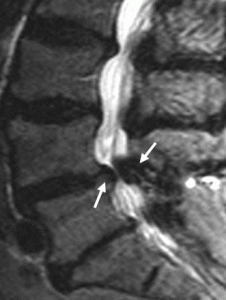
Lumbar Laminectomy
Laminectomy is one of the most common back surgeries. During a laminectomy, a surgeon removes partially or entirely the rear portion of the vertebrae. Bone spurs and ligaments that are pressing on nerves are removed at the same time. Lumbar laminectomy is performed to enlarged the spinal canal, and it is mainly used to treat lumbar spinal stenosis.
What is Lumbar Spinal Stenosis?
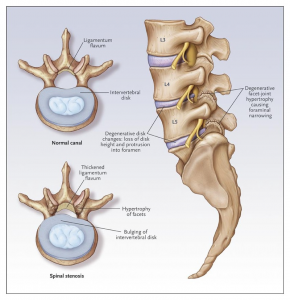
Figure 1. Lumbar spinal stenosis
As we age, the spine changes, often leading to a degeneration of the vertebrae, discs, muscles, and ligaments that together make up the spinal column. These changes may lead to spinal stenosis (Fig 1).
The term stenosis means narrowing. In spinal stenosis the spinal canal becomes smaller leading to less space for the nerve roots inside; as a consequence, the nerve roots are compressed causing neurological symptoms.
Symptoms and Diagnosis of Lumbar Stenosis
The most common symptom is increased pain and weakness in the legs with walking (claudication), which can markedly diminish one’s activity level. Patients with lumbar spinal stenosis are typically comfortable at rest but cannot walk far without developing leg pain. Pain relief is achieved, sometimes almost immediately, when they rest and sit down again.
The symptoms of lumbar stenosis generally develop slowly over time and usually occur in old people, symptoms may come and go. Lumbar stenosis symptoms may include:
- Leg pain (sciatica)
- Leg pain with walking (claudication)
- Tingling, weakness or numbness that radiates from the lower back into the buttocks and legs.
When a patient presents with the typical symptoms of lumbar spinal stenosis (leg pain, with or without back pain, which is aggravated by walking), a conclusive diagnosis is made using imaging studies. MRI is the preferred test to confirm lumbar spinal stenosis (Fig 2).
Treatment of Lumbar Spinal Stenosis
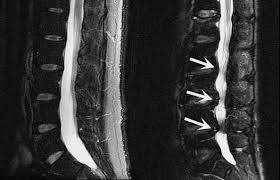
Figure 2. Normal lumbar spine (left) and spine stenosis (right)
Initially, the treatment of lumbar spinal stenosis is conservative. Conservative treatment includes the use of activity modification analgesics and epidural injections.
Surgery for lumbar spinal stenosis should only be considered if a patient’s ability to participate in everyday activities is unacceptably reduced and a concerted effort to relieve symptoms through non-operative means has failed.
Lumbar laminectomy has a high success rate. In most cases, lumbar laminectomy allows people to return to an active lifestyle. Depending on the characteristics and location of lumbar stenosis, several surgical techniques may be performed to treat this condition. Generally, during surgery only a part of the lamina is removed to decompress the spinal canal, thus preserving spine stability and avoiding the use of hardware.
Awesome Doctors for your Neurosurgery Needs
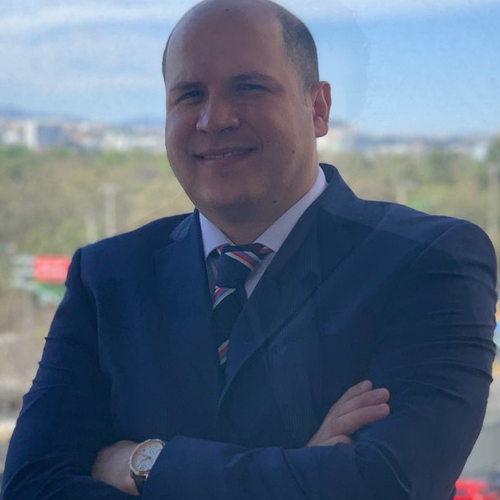
Dr. JJ Ramirez
Neurocirujano
Dr. Ramirez attended medical school at the Universidad Autonoma of Guadalajara School of Medicine in Guadalajara Mexico. Dr. Ramirez performed his Neurosurgery training at the National Institute of Neurology and Neurosurgery in Mexico City
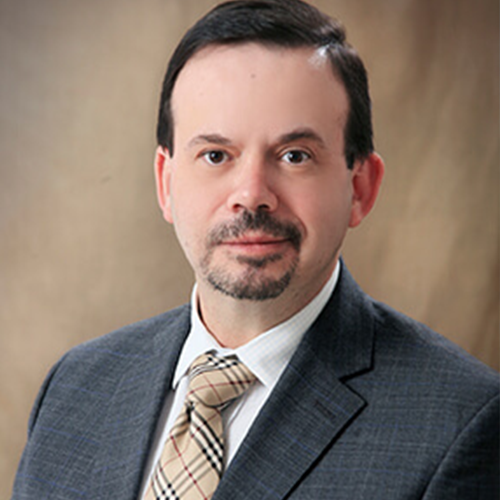
Dr. Ramiro Pérez
Neurosurgeon
Dr. Ramiro Pérez attended medical school at the University of Guadalajara School of Medicine in Guadalajara México. Dr. Pérez performed his Neurosurgery training in Centro Medico Siglo XXI IMSS and has been practicing his specialty for more than 13 years.

Dr. Felipe Nares
Neurosurgeon
Dr. Nares attended medical school at the University of Aguascalientes, He is trained to perform anterior and lateral approaches to the spine from the cervical to the lumbar spine, as well as minimally invasive surgery.

Dr. Luis A. Robles
Neurosurgeon
Dr. Luis Robles has been practicing neurosurgery specialty for 20 years. Dr. Robles is academically active, he participates as a section editor in the World Neurosurgery journal and he has published several articles in different neurosurgery international journals.

